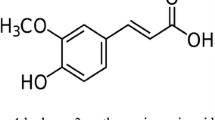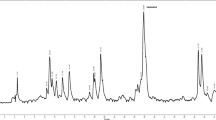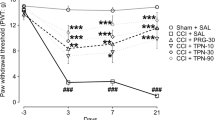Abstract
Background
Flavonoids are popular substances in the literature, with proven effects on cardiovascular, neoplastic and neurodegenerative diseases. Antioxidant effect is the most pronounced and studied one. Among thousands of flavonoids, quercetin (QUE) is a prototype with significant antioxidant effects. This study aims to demonstrate the effects of QUE in an experimental rat model of chronic constriction injury (CCI).
Method
A two-level study was designed with 42 adult Wistar rats that were randomly assigned to different groups. In the first part, animals in sham, control, quercetin, morphine and gabapentine groups received chronic constriction injury to their sciatic nerves and received a single dose of QUE, morphine and gabapentine. In the second part, different dose regimens of QUE were administered to different groups of animals. Pre-injury and post-injury assessments for mechanical hypersensitivity, thermal sensitivity, locomotor activity and anxiety were recorded and statistical comparisons were performed between different groups.
Results
Comparison of QUE with morphine and gabapentine has revealed significant effects of this agent in the current chronic constriction injury model. QUE was significantly superior to Gabapentine and morphine in terms of alleviating mechanical and thermal hypersensitivity. Additionally, pre-injury administration of QUE for 4 days demonstrated long-term effectiveness on mechanical hypersensitivity.
Conclusions
This preliminary report the on effects of QUE in a chronic constriction injury model proved significant effects of the agent, which should be supplemented with different studies using different dose regimens.



Similar content being viewed by others
References
Anjaneyulu M, Chopra K (2003) Quercetin, a bioflavonoid, attenuates thermal hyperalgesia in a mouse model of diabetic neuropathic pain. Prog Neuro-Psychopharmacol Biol Psychiatry 27:1001–1005
Anjaneyulu M, Chopra K (2004) Quercetin attenuates thermal hyperalgesia and cold allodynia in STZ-induced diabetic rats. Indian J Exp Biol 42:766–769
Arcos M, Palanca JM, Montes F, Barrios C (2013) Antioxidants and gabapentin prevent heat hypersensitivity in a neuropathic pain model. J Investig Surg 26:109–117
Bennett GJ, Xie YK (1988) A peripheral mononeuropathy in rat that produces disorders of pain sensation like those seen in man. Pain 33:87–107
Coderre TJ, Kumar N, Lefebvre CD, Yu JSC (2007) A comparison of the glutamate release inhibition and anti-allodynic effects of gabapentin, lamotrigine, and riluzole in a model of neuropathic pain. J Neurochem 100:1289–1299
Comalada M, Camuesco D, Sierra S, Ballester I, Xaus J, Galvez J, Zarzuelo A (2005) In vivo quercitrin anti-inflammatory effect involves release of quercetin, which inhibits inflammation through down-regulation of the NF-kappaB pathway. Eur J Immunol 35:584–592
De Vry J, Kuhl E, Franken-Kunkel P, Eckel G (2004) Pharmacological characterization of the chronic constriction injury model of neuropathic pain. Eur J Pharmacol 491:137–148
Dworkin RH (2002) An overview of neuropathic pain: syndromes, symptoms, signs, and several mechanisms. Clin J Pain 18:343–349
Filho AW, Filho VC, Olinger L, de Souza MM (2008) Quercetin: further investigation of its antinociceptive properties and mechanisms of action. Arch Pharm Res 31:713–721
Fundytus ME (2001) Glutamate receptors and nociception: implications for the drug treatment of pain. CNS Drugs 15:29–58
Hara K, Haranishi Y, Kataoka K, Takahashi Y, Terada T, Nakamura M, Sata T (2014) Chlorogenic acid administered intrathecally alleviates mechanical and cold hyperalgesia in a rat neuropathic pain model. Eur J Pharmacol 723:459–464
Hara K, Nakamura M, Haranishi Y, Terada T, Kataoka K, Sata T (2012) Antinociceptive effect of intrathecal administration of hypotaurine in rat models of inflammatory and neuropathic pain. Amino Acids 43:397–404
Hopkins SC, Zhao FY, Bowen CA, Fang X, Wei H, Heffernan ML, Spear KL, Spanswick DC, Varney MA, Large TH (2013) Pharmacodynamic effects of a D-amino acid oxidase inhibitor indicate a spinal site of action in rat models of neuropathic pain. J Pharmacol Exp Ther 345:502–511
Ishisaka A, Ichikawa S, Sakakibara H, Piskula MK, Nakamura T, Kato Y, Ito M, K-i M, Tsuji A, Kawai Y, Terao J (2011) Accumulation of orally administered quercetin in brain tissue and its antioxidative effects in rats. Free Radic Biol Med 51:1329–1336
Maciel RM, Costa MM, Martins DB, França RT, Schmatz R, Graça DL, Duarte MMMF, Danesi CC, Mazzanti CM, Schetinger MRC, Paim FC, Palma HE, Abdala FH, Stefanello N, Zimpel CK, Felin DV, Lopes STA (2013) Antioxidant and anti-inflammatory effects of quercetin in functional and morphological alterations in streptozotocin-induced diabetic rats. Res Vet Sci 95:389–397
Manthey JA (2000) Biological properties of flavonoids pertaining to inflammation. Microcirculation 7:S29–S34
Meisner JG, Marsh AD, Marsh DR (2010) Loss of GABAergic interneurons in laminae I-III of the spinal cord dorsal horn contributes to reduced GABAergic tone and neuropathic pain after spinal cord injury. J Neurotrauma 27:729–737
Okamoto T (2005) Safety of quercetin for clinical application (review). Int J Mol Med 16:275–278
Ossola B, Kaariainen TM, Mannisto PT (2009) The multiple faces of quercetin in neuroprotection. Expert Opin Drug Saf 8:397–409
Pasero C (2004) Pathophysiology of neuropathic pain. Pain Manag Nurs 5:3–8
Pietta PG (2000) Flavonoids as antioxidants. J Nat Prod 63:1035–1042
Quinn LP, Stean TO, Trail B, Duxon MS, Stratton SC, Billinton A, Upton N (2003) LABORAS™: initial pharmacological validation of a system allowing continuous monitoring of laboratory rodent behaviour. J Neurosci Methods 130:83–92
Raygude KS, Kandhare AD, Ghosh P, Ghule AE, Bodhankar SL (2012) Evaluation of ameliorative effect of quercetin in experimental model of alcoholic neuropathy in rats. Inflammopharmacology 20:331–341
Ro LS, Chang KH (2005) Neuropathic pain: mechanisms and treatments. Chang Gung Med J 28:597–605
Schultke E, Kendall E, Kamencic H, Ghong Z, Griebel RW, Juurlink BH (2003) Quercetin promotes functional recovery following acute spinal cord injury. J Neurotrauma 20:583–591
Song Y, Liu J, Zhang F, Zhang J, Shi T, Zeng Z (2013) Antioxidant effect of quercetin against acute spinal cord injury in rats and its correlation with the p38MAPK/iNOS signaling pathway. Life Sci 92:1215–1221
Terada T, Hara K, Haranishi Y, Sata T (2011) Antinociceptive effect of intrathecal administration of taurine in rat models of neuropathic pain. Can J Anaesth 58:630–637
Theoharides TC (2007) Treatment approaches for painful bladder syndrome/interstitial cystitis. Drugs 67:215–235
Valerio DA, Georgetti SR, Magro DA, Casagrande R, Cunha TM, Vicentini FT, Vieira SM, Fonseca MJ, Ferreira SH, Cunha FQ, Verri WA Jr (2009) Quercetin reduces inflammatory pain: inhibition of oxidative stress and cytokine production. J Nat Prod 72:1975–1979
Vanhees K, van Schooten FJ, van Waalwijk van Doorn-Khosrovani SB, van Helden S, Munnia A, Peluso M, Briede JJ, Haenen GR, Godschalk RW (2013) Intrauterine exposure to flavonoids modifies antioxidant status at adulthood and decreases oxidative stress-induced DNA damage. Free Radic Biol Med 57:154–161
Yowtak J, Lee KY, Kim HY, Wang J, Kim HK, Chung K, Chung JM (2011) Reactive oxygen species contribute to neuropathic pain by reducing spinal GABA release. Pain 152:844–852
Yowtak J, Wang J, Kim HY, Lu Y, Chung K, Chung JM (2013) Effect of antioxidant treatment on spinal GABA neurons in a neuropathic pain model in the mouse. Pain 154:2469–2476
Author information
Authors and Affiliations
Corresponding author
Ethics declarations
Funding
No funding was received for this research.
Conflicts of interest
None.
Animal experiments
All applicable international, national, and/or institutional guidelines for the care and use of animals were followed. All procedures performed in studies involving animals were in accordance with the ethical standards of the institution or practice at which the studies were conducted.
Financial disclosure
None of the authors has a financial interest in any of the products, devices, or drugs mentioned in this manuscript.
Additional information
Comment
An interesting animal study that demonstrates that a flavonoid, quercitin, when systemically administered could favorably influence the presumed alodynia and hypersensitivity that follows a chronic constrictive injury applied to the rat sciatic nerve. The data is believable. As the authors point out, numerous mechanisms are possible and have as of yet to be determined. The effect of quercitin relies on administering the agent at and/or before the time of nerve injury and not afterwards, which limits its clinical applicability. Nevertheless, the results are interesting and deserve follow-up studies.
Michel Kliot
Illinois, USA
The authors have evaluated the effect of Quercetin, a naturally occurring flavinol with anti-oxidant properties on a well-studied neuropathic pain model in rats. Quercetin administered and shortly after the injury and 3 weeks later led to a significant attenuation of chronic pain related behavior. Curiously, treating the rats prior to sciatic nerve injury with Quercetin had an even more pronounced effect. The findings are intriguing. As the authors point out, various dosage levels and time scales are required in order to obtain a firmer grasp on the potential usefulness of this type of therapy.
Zvi Harry Rappaport
Petah-Tiqva, Israel
Rights and permissions
About this article
Cite this article
Çivi, S., Emmez, G., Dere, Ü.A. et al. Effects of quercetin on chronic constriction nerve injury in an experimental rat model. Acta Neurochir 158, 959–965 (2016). https://doi.org/10.1007/s00701-016-2761-0
Received:
Accepted:
Published:
Issue Date:
DOI: https://doi.org/10.1007/s00701-016-2761-0




